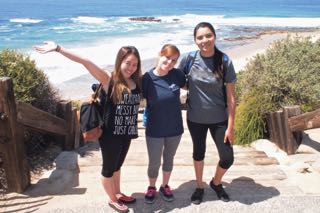
We visited for a second week but with a much better low tide.
| 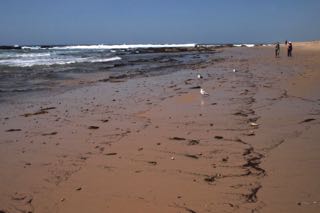
-
| 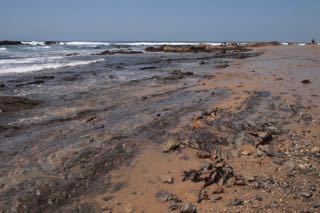
-
|
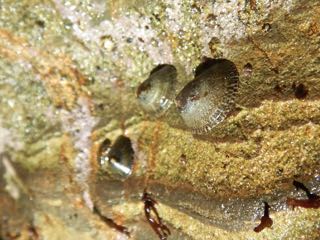
In a crevice, the closest limpet, at least, is Lottia fenestrata.
| 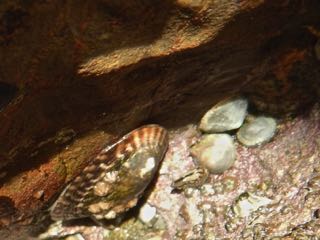
Owl limpet (Lottia gigantea) and a few pulmonate limpets (Trimusculus reticulatus) further into the same crevice, well under an overhang
| 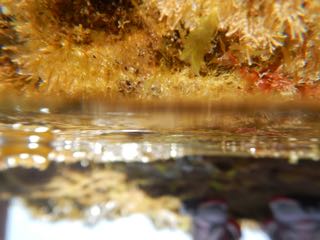
-
|
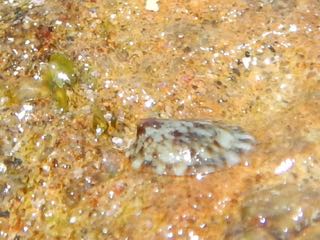
Tentative: Lottia gigantea (owl limpet) juvenile. If correct, this is the smallest one I have ever seen, maybe 6mm length, and with even maybe (?) with the protoconch preserved. I have no other explanation of what species it might be with an apex that far anterior and its head had pigmentation, as only L. gigantea and L. limatula have among the 20 or so California Lottia spp. The owl limpet is well known to have an anterior apex with a thickened shell, like a train rake, it uses as an adult on the territories it defends against all intruders, including other owl limpets. By then the animal has switched sex from a "satellite male" on the fringe of a territory to a full size female territorial limpet. But this one has a ways to go, if my identification is correct.
| 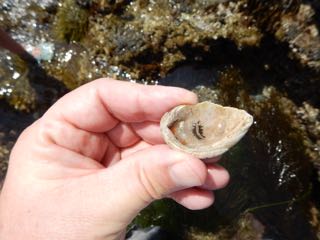
A small upside down sacoglossan that I found attached to surf grass.
| 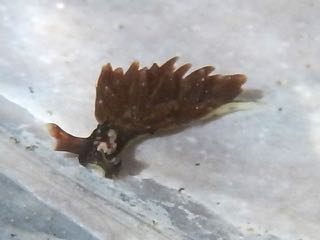
This small sacoglossan sea slug is Aplysiopsis enteromorphae, which eats green algae in the genera, Chaetomorpha and Cladophora, not Enteromorpha, so its name is misleading. Thanks to Pat Krug, Cynthia Trowbridge, and Brenna Green for help with the identification. See here for more details and especially the two cited references from 1993 by Cynthia Trowbridge, and also her 2002 review in Veliger 45: 1-24.
|
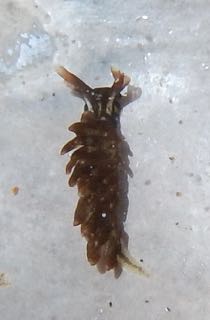
-
| 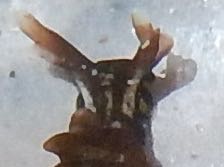
Aplysiopsis enteromorphae has two white lines on its head surrounding the eyes.
| 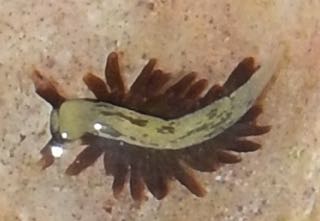
This sacoglossan also has marbled pigmentation on the sole of its foot.
|
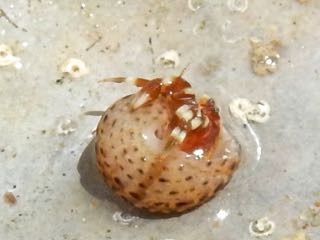
Inside a small Tegula eiseni shell, this hermit crab is likely a juvenile Pagurus venturensis Coffin, 1957, which is similar but distinct from P. hirsutiusculus (and P. samuelis) but is more southern, mostly only in southern California. P. venturensis and P. hirsutiusculus are only known to co-occur in the vicinity of Monterey, near the southern end of the range of the latter species. P. venturensis can be distinguished from either P. hirsutiusculus or P. samuelis by its "longer and narrower shield and the tuberculate armature of the dactyl and propodus of the third left pereopod" (Crain and McLaughlin, 1993: 1008). According to crustacean expert, Greg Jensen, cautioned that it is difficult to confidently identify this hermit to a particular species from this and the following images alone. Jensen also warned that Pagurus holmi Ng & McLaughlin, 2009, which has been reported only from Washington, should also look similar to this if it is indeed a valid species, and if its range happens to be more widespread than currently reported. Cited source: here.
| 
-
| 
-
|

-
| 
-
| 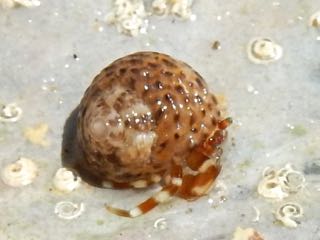
-
|

-
| 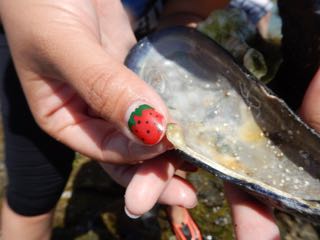
-
| 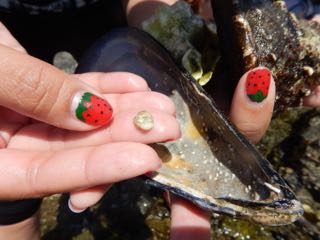
One of the small whitish slipper limpets of the gastropod family, Calyptraeidae, that are difficult to identify without dissecting the animal away from the internal shell structures. This as originally on a snail shell.
|
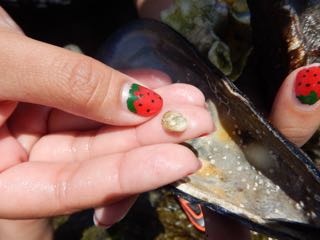
-
| 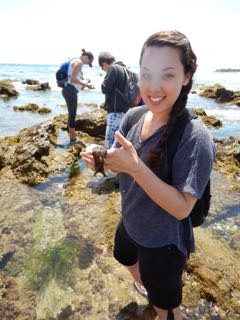
-
| 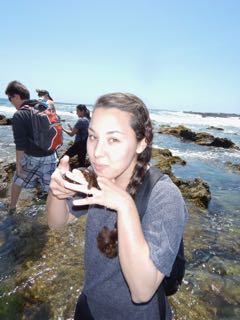
-
|

-
| 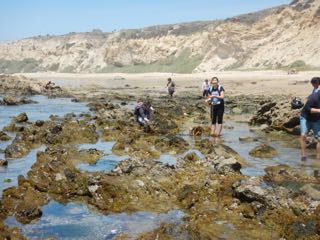
-
| 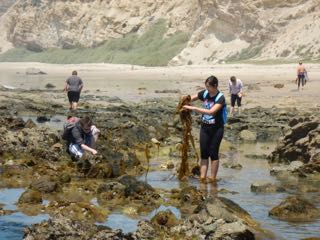
-
|
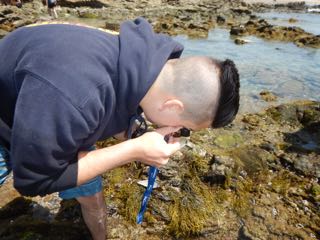
-
| 
-
| 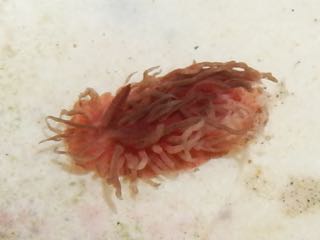
A very beat up Hopkins rose nudibranch.
|
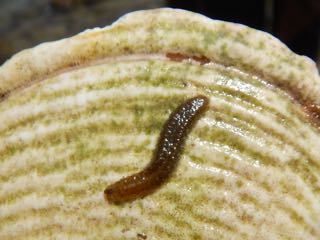
-
| 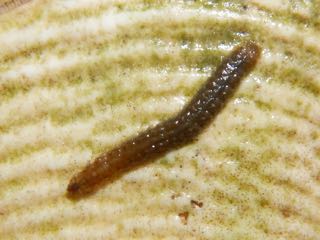
According to polychaete expert, Leslie Harris, this scale worm (Polynoidae) is either Halosydna brevisetosa or H. johnsoni. They overlap in color patterns, but differ in the shape of their chaetae.
| 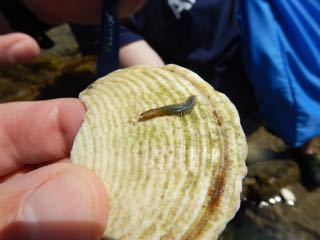
-
|

-
| 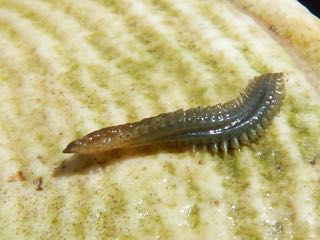
-
| 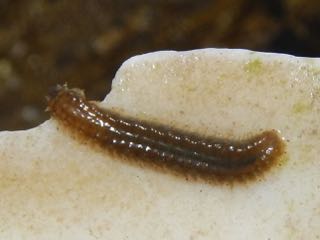
Leslie Harris noted that many species of Halosydna have subdistal pigmented spots on the dorsal cirri, which I first thought might be eyespots of some sort.
|
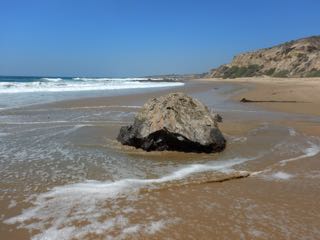
-
| 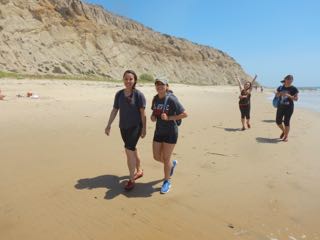
-
| 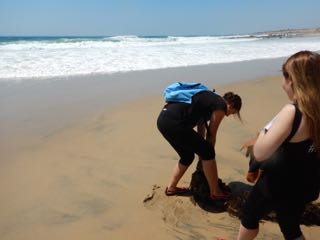
-
|

-
| 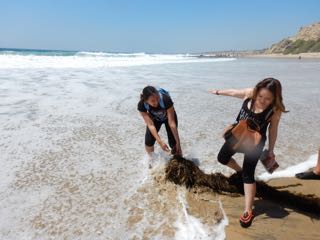
The feather boa kelp, Egregia menziesii, has been extremely rare this warm year south of Los Angeles in the intertidal, but we found a couple of large feather boa kelps intertwined and ripped up from the subtidal. One of their holdfasts had an assortment of chaetopterid polychaete tubes, a red compound tunicate,
worm snail tubes, branching bryozoans, hydroids, shredded wheat serpulids, and an interesting delicate Codium sp., all seeming healthy and freshly terrestrial.
The other holdfast had a chunk of mudstone riddled by date mussels (Adula falcata).
The feather boa had lots of shaggy growth and might have eventually producing too much drag for the substrate, still attached holdfasts.
The date mussels might be culprits as they are expected to weaken the mudstone with their burrows.
| 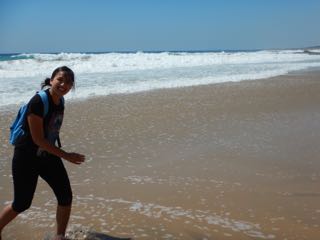
-
|
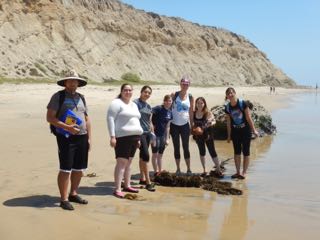
-
| 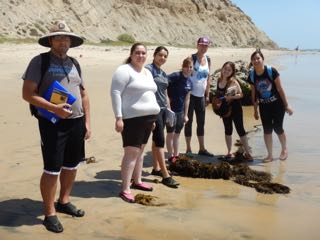
-
| 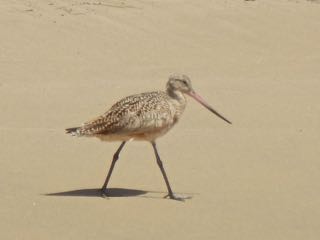
marbled godwit
|
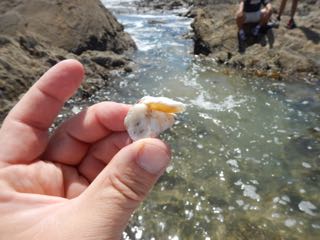
-
| 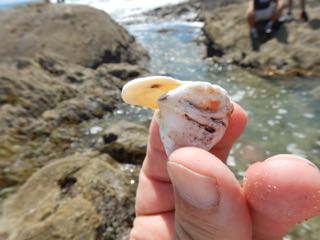
This Chamidae (jewel box clam) paired shell was still attached by the clam's ligament, but did not seem to
match up very closely. Do soft parts especially siphons make up the difference? We need to look at some uneroded shells.
| 
-
|
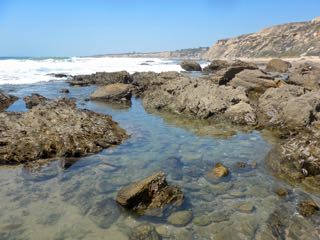
-
| 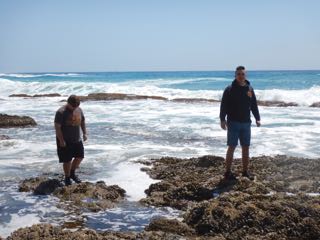
-
| 
-
|
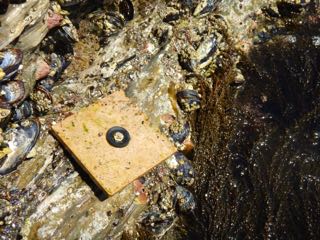
A settlement plate deployed by unknown researchers, who also had blue Tuffy dish scrubbers,
a classic marine ecology approach for also assessing those species including mussels with settlement preference favoring a Tuffy to a plate, or perhaps surviving better in one after settling.
| 
Gooseneck barnacles (Policipes polymerus) and California mussels (Mytilus californianus)
| 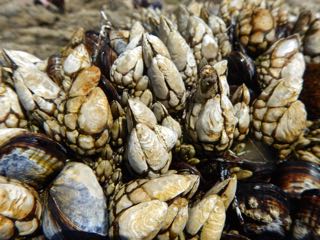
A barnacle morph of the southern finger limpet (Lottia austrodigitalis) has
a camouflaged shell color matching the plates of its host gooseneck barnacle. If you cannot see it, look in the center.
|
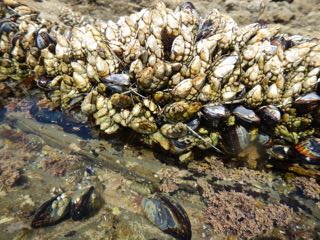
-
| 
Another Lottia austrodigitalis barnacle morph.
| 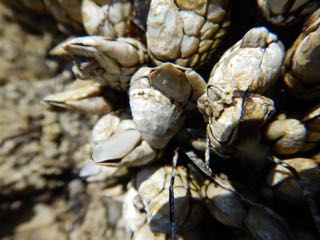
-
|
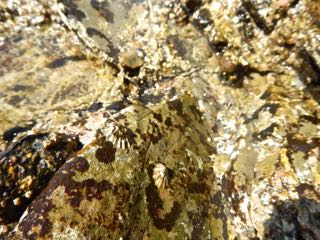
Lottia scabra like those near the center of this image were rare at Crystal Cove on this visit.
In contrast, the more southern and usually smaller fine-ribbed limpets, L. conus, were probably the most common limpet we saw, but this species is often mistaken
for juveniles of its close relative, L. scabra, and seems to be increasingly common in Orange County.
| 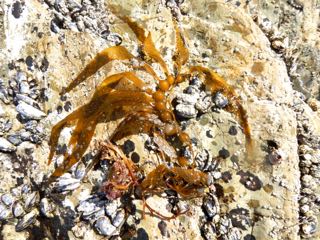
New growth from a young giant kelp (Macrocystis pyrifera) that suffered the fate of many a young alga.
| 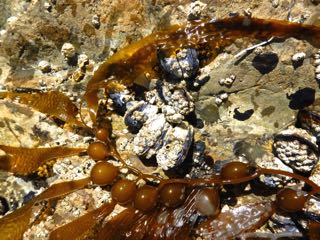
Most of the giant kelp fronds were encrusted with the white bryozoan, Membranipora tuberculata. We looked for
but have not yet found the nudibranch predator, Corambe steinbergae, which feeds on these bryozoan zooids.
|

According to Wikipedia, giant kelp grows with stipe lengthening and blade splitting with small tears where the blade and stipe meet. This splits the stipe into two and the float-like pneumatocysts grow after the first few blade split.
| 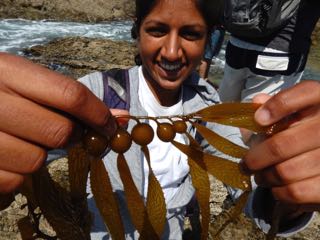
-
| 
A southern spiny chiton, Nuttallina fluxa, above what might be a rough limpet, Lottia scabra.
|
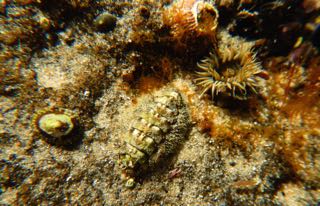
Another southern spiny chiton, Nuttallina fluxa
| 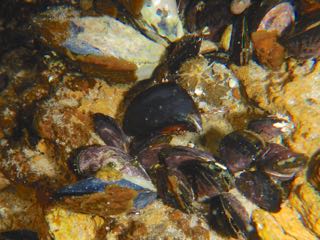
Our three most common SoCal rocky intertidal mussels: the introduced Mytilus galloprovincialis
in the center (placed there), above a cluster of purplish Brachidontes adamsianus, and three blue Mytilus californianus on the left.
| 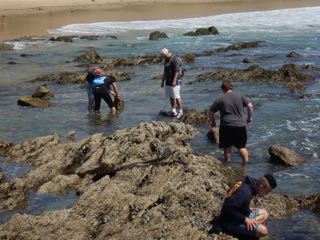
-
|

-
| 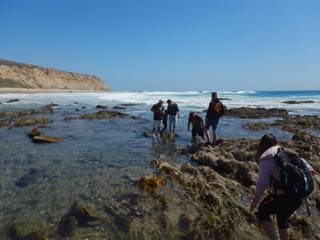
-
| 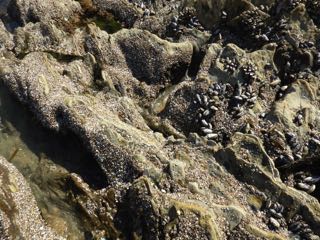
-
|
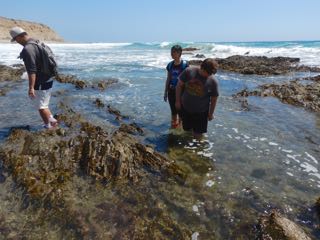
-
| 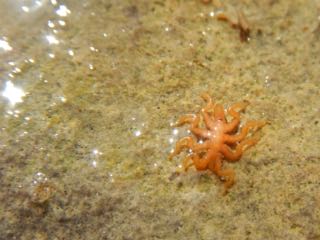
A pycnogonid (sea spider) tentatively identified as Pycnogonum stearnsi.
I saw it Friday on the underside of a rock in Orange Co., CA, and was impressed it could crawl sorta steady compared to how slow I would have imagined a
sea spider must crawl.
| 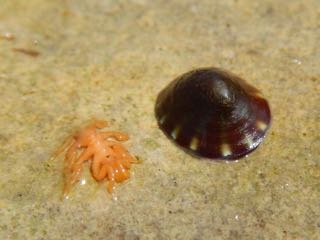
Here I placed a pulmonate limpet, Williamia peltoides, found on the same rock next to the sea spider.
Note that the apex of this so-called false limpet is posterior, not anterior as in a true limpet, so this one is facing away, whereas the sea spider is now facing forward.
|
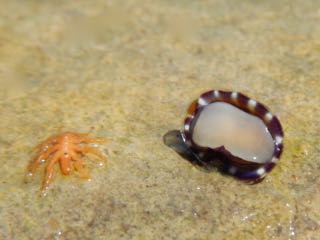
-
| 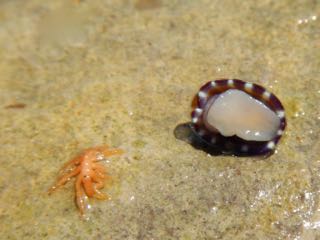
The limpet on the right is Williamia peltoides, one of two species of the siphon limpet (Siphonariidae) genus,
Williamia, that are present in southern California.
W. peltoides is thought to be wide ranging between Oregon and Peru and with type material collected long ago at Cabo San Lucas by the well known
collector, John Xantus (see Wikipedia: John Xantus). The other species, W. subspiralis, is even more poorly known, described from Catalina Island
specimens and it is more restricted in its range, extending
from central California to central Baja California and it appears to only in in the subtidal (15-60m depth). Compared to the W. peltoides in this and previous images,
W. subspiralis has a higher shell with a hooked apex (McLean 1998).
Like other pulmonate siphon limpets, members of Williamia have both a lung and a secondary gill, and are unusual in living mostly submerged
in the low intertidal or subtidal, not higher in the intertidal as in most Siphonaria spp.
Reference cited:
McLean, 1998 in Veliger.
| 
Williamia peltoides is the pulmonate limpet here with its head to the left.
Rachel Collin has observed the development of this species and noted
that this species has egg masses from which planktonic veligers emerge (Collin 2000).
Not much else is known about the
biology of this species. On one occasion only out of maybe five in the past
where I dropped one of these in ethanol, that time it rapidly colored
the ethanol with the same lavender
color seen at the mantle fringe. Perhaps it released a defensive ink of some sort on that occasion.
Reference cited:
Collin, 2000 in Nautilus
|
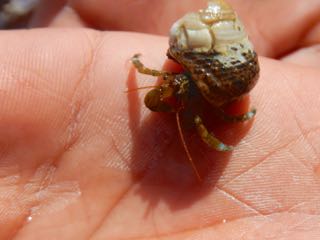
-
| 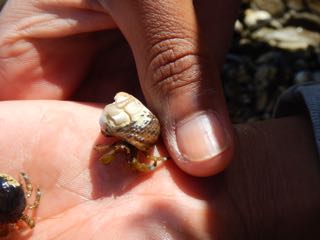
-
| 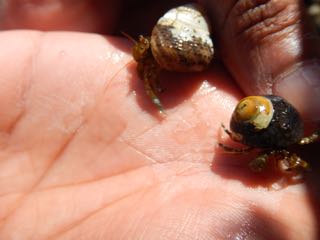
I observed a fight in progress among these two Pagurus samuelis hermit crabs in a tidepool.
The one in the Chlorostoma funebralis shell on the bottom seemed smaller than the other but it was definitely doing its best to convince the other P. samuelis hermit in a
Tegula eiseni shell to exchange shells. It was an unsuccessful attempt but it had an impressively feisty attitude. Maybe the fight is still going on.
|
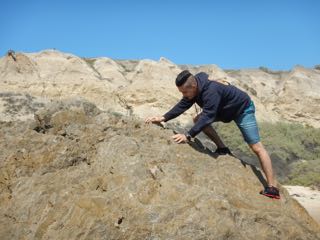
The splash zone littorine snail, Littorina keenae, was found clear near
the top of a large boulder that was otherwise quite bare at that height.
| 
-
| 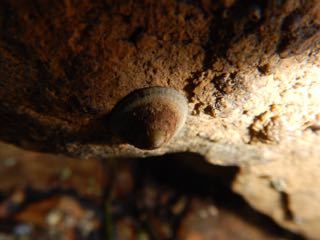
-
|

-
| 
-
| 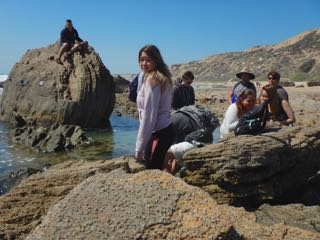
-
|
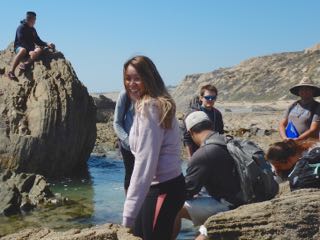
-
| 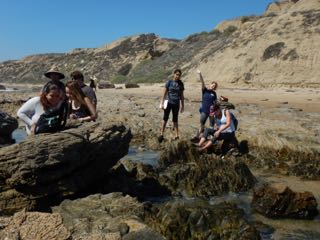
-
| 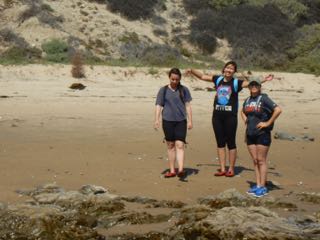
-
|

The purplish ribbed mussel, Brachidontes adamsianus, is now very common at Crystal Cove.
It is a more southern species described first from islands off the Pacific coast of Panama, and also common on the Mexican mainland. I first observed it maybe 15 years ago at Crystal Cove,
but since then it has become much more common in Orange County, for example now also common at Dana Point.
| 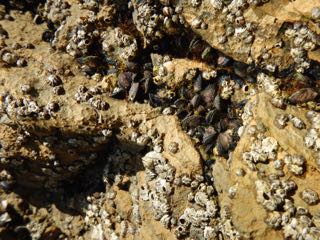
-
| 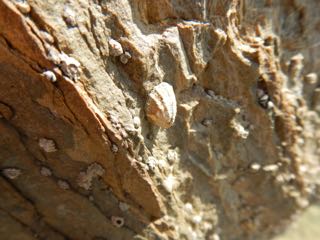
rock morph of the southern finger limpet (Lottia austrodigitalis)
|
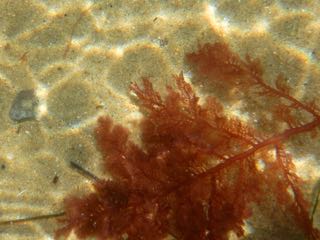
-
| 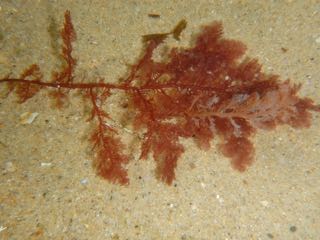
-
| 
-
|
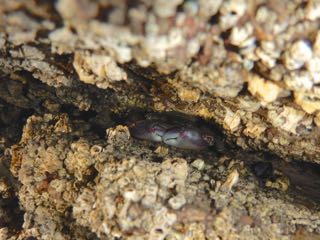
-
| 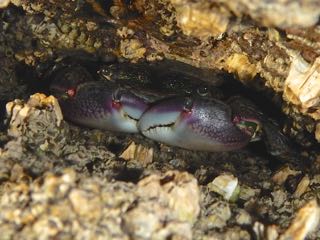
This Pachygrapsus crassipes (lined shore crab) back in a crevice was
difficult to see at all until I reflected some sunlight with a mirror.
| 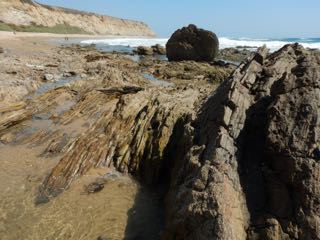
-
|

Two sometimes similar-appearing but not closely related limpet species:
A smaller Lottia sp. B is on the left and L. fenestrata is on the right. L. sp.B is a working name (Hewson and Eernisse, MS.) for
what we plan to describe as a more northern close relative of
the Gulf of California species, Lottia strigatella . Note the radial line pattern in L. sp. B, when uneroded, is never seen in L. fenestrata.
| 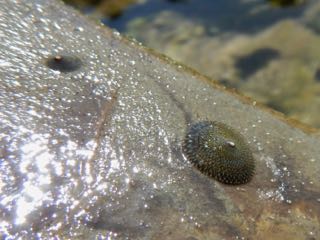
-
| 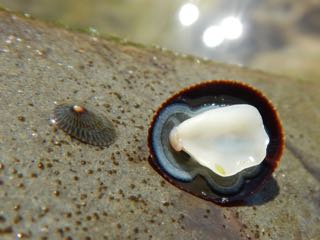
Lottia sp. B (left) and L. fenestrata (right) overturned. In southern California, the shell interior of L. fenestrata
varies from this dark chocolate to light blue. L. sp. B and L. strigatella have a light blue tinge to their whitish shell interior compared with other similar Lottia species.
|

-
| 
-
| 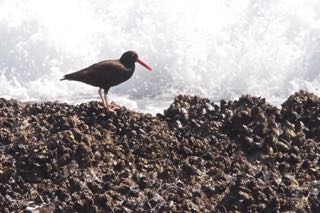
black oystercatcher (Haematopus bachmani; Charadriiformes: Haematopodidae)
|
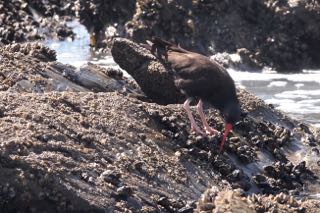
Black oystercatchers are famous for their predation on owl limpets but I watched this pair quite successfully
removing and eating California mussels (Mytilus californianus). I saw them each get one before I left.
| 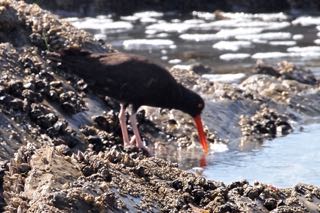
-
| 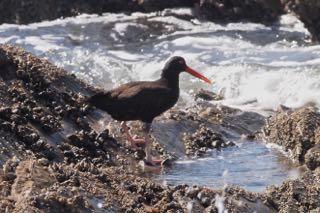
-
|

-
| 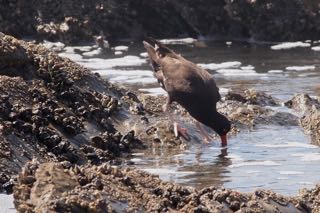
-
| 
-
|
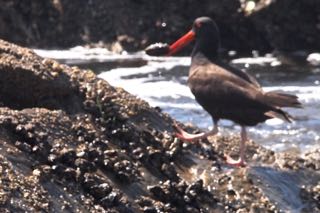
This black oystercatcher just got the mussel it was after, soon to be hammered open.
| 
-
| 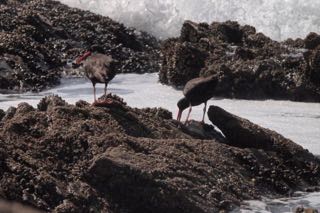
-
|

-
| 
-
| 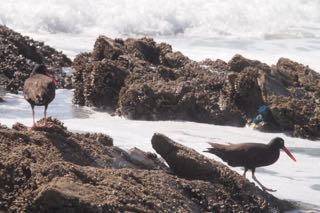
-
|
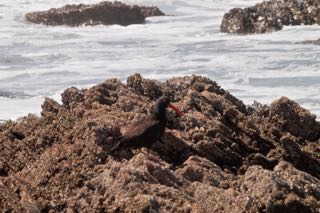
-
| 
-
| 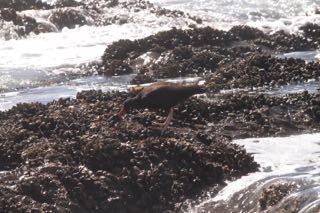
The other black oystercatcher got its own mussel.
|
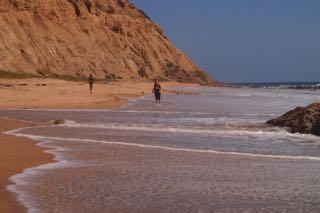
-
| 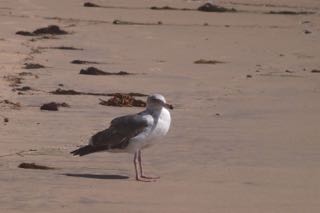
-
| 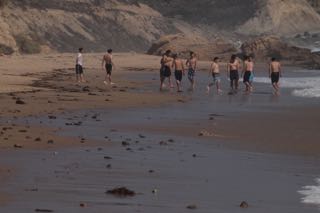
-
|
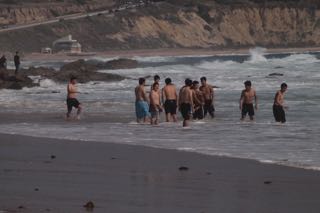
-
| 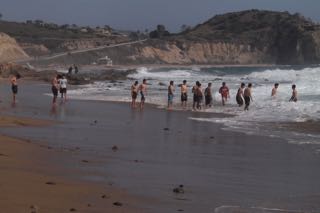
-
| 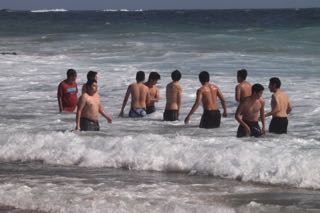
-
|

-
| 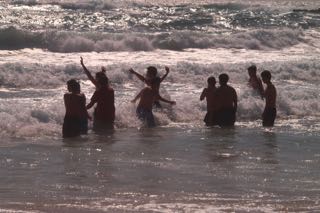
-
| 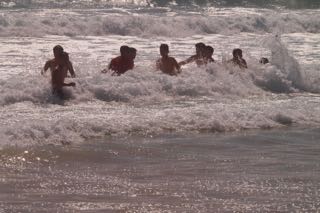
-
|
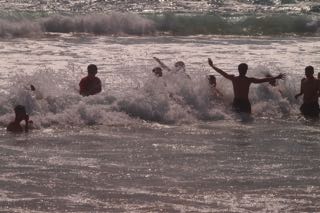
-
| 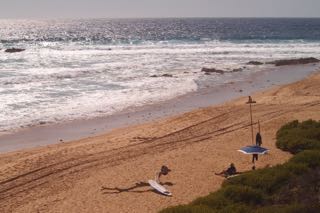
-
| 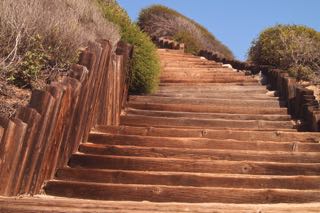
-
|
 Under Construction!
Under Construction! Under Construction!
Under Construction!